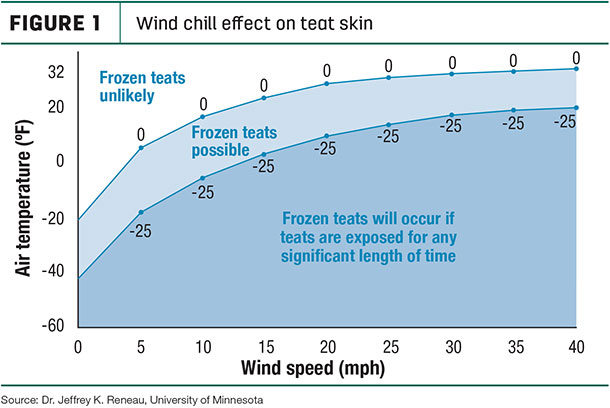During these short and frigid days, producers should think about winter management for optimal udder health. By now a plan should be in place, but revisiting best practices from time to time is always a good idea. The consequences of freezing weather to cows can be devastating and, in the case of Staphylococcus aureus infections, potentially last throughout the rest of the year.
Winter’s effect on teat health
The reason a teat’s condition changes is due to cellular stress. Rapid dehydration leads to skin cell disruption, followed by a loss of natural moisturizing. In an effort to compensate, skin cells start overproducing and slow down the natural renewal process of exfoliation. The result is a thickening accumulation of old cells, which forms a flaking layer of dry skin.
Additionally, teats may outright freeze under the right conditions. Studies have shown that wind chill matters more than ambient temperature. If the wind chill remains above 0°F (-18°C), frozen teats are unlikely. Between 0ºF (-18°C) and -25°F (-32°C), frozen teats are possible. If the wind chill is below -25°F (-32°C) and teats are wet, they can freeze in less than one minute.

Even without the potential for frozen teats, skin that is compromised by flaking and chapping increases the risk of infectious diseases such as Herpes mammillitis, pseudocowpox and papilloma (teat warts). Heifers and fresh cows are at a higher risk. Because temperature changes and wind chill are the major predisposing factors to winter teat changes, the main objective should be to control exposure to weather stressors as much as possible.
How to avoid frozen teats
In order to reduce exposure in cold weather, drop curtains in freestalls to reduce wind speed and help eliminate wind chill. Avoid drafts by controlling ventilation and check for malfunctioning curtains. Also check for doors left open in tiestall and stanchion barns, which can create tunnel ventilation. If animals have to go outside, provide wind-breakers.
The condition of stalls and the milking parlor will also have an effect on the herd’s teat health. Having comfortable, dry areas or stalls for animals is critical, so bedding must be kept clean and dry by frequent changes. Wet bedding not only increases body surface heat loss, but also leads to wet teats and potentially frostbite. In the parlor, the milking machine is a teat stressor. At a time when teats may already be stressed by the cold, properly functioning equipment is essential. High vacuum levels and fast pulsation rates result in poor blood flow and inadequate teat massage. Overmilking should be avoided and equipment cleaned and sanitized after each milking session.
Some producers believe there is no need to post-dip when temperatures drop below freezing because they think the temperature decreases bacterial growth. However, studies have shown that completely eliminating teat disinfection actually increases the spread of contagious mastitis pathogens. Therefore, it is important to continue an efficient teat dip program to assist in mastitis control during the winter months. It may also help keep good teat skin condition during the transition from winter to spring, potentially reducing SCC fluctuations. In freezing temperatures above 20°F (-7°C), conditioning pre/post teat disinfectants should be used, as they are designed to improve overall skin condition, teat end health and reduce hyperkeratosis. Their conditioning agents reduce the potential for chapped skin, which reduces the chances of bacteria entering the teat canal. When temperatures fall below 20°F (-7°C), producers should consider using a high emollient winter teat disinfectant.
Good hygiene practices, such as the use of gloves and individual towels, should be in place at all times and teats should be completely dry before milking. Water use should be minimal as it enhances chilling. After dipping with a disinfectant with proven germicidal efficacy, irritated skin should be gently blotted as opposed to rubbed to minimize damaged, cracked teats.
As far as post-milking practices, avoid putting animals in extreme wind chills after post-milking teat disinfection to allow time for the product to dry. If this cannot be avoided, steps to minimize frozen teat dip should be instituted, such as blotting off excess disinfectant. It is important to monitor fresh animals because they are more susceptible and their teats may easily chap and freeze. Barrier dip should be discontinued in extremely low temperatures because it normally takes longer to dry.
Often forgotten in a winter management program is the storage of teat disinfectants. They may freeze if stored in uninsulated, unheated buildings. If freezing does occur, it is possible it may affect the chemistry of the active ingredients. Thawing may or may not affect the product’s properties, so producers should check with the manufacturer for specific information.
Protecting teat health during the winter months can take additional time and planning. However, the rewards can far outweigh the inconvenience. ![]()
Paula Mercadante is the solution manager for herd health and training coordinator for DeLaval.
PHOTO: Photo courtesy of DeLaval.





